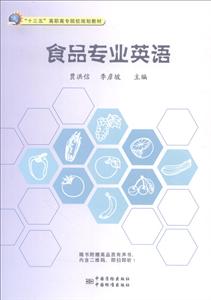-
>
湖南省志(1978-2002)?铁路志
-
>
公路车宝典(ZINN的公路车维修与保养秘籍)
-
>
晶体管电路设计(下)
-
>
基于个性化设计策略的智能交通系统关键技术
-
>
德国克虏伯与晚清火:贸易与仿制模式下的技术转移
-
>
花样百出:贵州少数民族图案填色
-
>
识木:全球220种木材图鉴
食品专业英语 版权信息
- ISBN:9787502645304
- 条形码:9787502645304 ; 978-7-5026-4530-4
- 装帧:一般胶版纸
- 册数:暂无
- 重量:暂无
- 所属分类:>>
食品专业英语 内容简介
食品专业英语课程是高职高专院校食品类专业学生的一门重要的专业课。根据高职高专院校培养高技能型人才的培养目标,食品专业英语课程的主要任务是引导学生掌握一定的食品专业英语词汇和专业术语,学会专业英语的翻译技巧,提高学生专业英文文献的查找、阅读和翻译水平,并能够独立翻译和撰写英文摘要。教材建设关系高校教学质量和教学效果的提升,做好教材建设、提高教学水平、丰富教学内容及促进教学方法改革具有重要而紧迫的意义。为适应新形势,本教材紧密结合当代高职高专学生的具体情况和特点,运用新的信息技术和手段,在与企业一线技术和管理人员充分、深入合作的基础上编写完成。
食品专业英语 目录
**节 翻译的方法
第二节 翻译的难点
Unit 2 Nutrients
Summary
Reading Material 1 Carbohydrates
Reading Material 2 Proteins
Reading Material 3 Lipids
Reading Material 4 Vitamins
Reading Material 5 Minerals
Unit 3 Food Raw Material
Summary
Reading Material 1 Eggs
Reading Material 2 Cerea1
Reading Material 3 Meat
Reading Material 4 Fruit and Vegetables
Reading Material 5 Legume
Reading Material 6 Milk
Unit 4 Flld Processing Technology
Reading Material 1 Bread Processing Technology
Reading Material 2 Vegetable Processing Technology
Reading Material 3 Sausage Processing Technology
Reading Material 4 Milk Products Processing Technology
Unit 5 Food Preservation
Summary
Reading Material1 Food Preservation by Drying
Reading Material 2 Food Preservation by Pickling and Curing
Reading Material 3 Food Irradiation
Reading Material 4 Food Preservation by Gas
Unit 6 Food Safety and Quality Control
Summary 1 Food Safety
Summary 2 Food Quality and Management
Reading Material 1 GMP
Reading Material 2 HAGGP
专业术语
参考文献
食品专业英语 节选
Reading Material 3 Lipids Introduction Lipids are a diverse group of fats and fatlike substances. The word "lipid" isdefined as "any group of substances that are soluble in organic solvents such as hy-drocarbons, benzene, alcohols, ether, and chloroform, but are only sparinglysoluble in water, they constitute the principal structural components of living ceilswith proteins and carbohydrates. They also include some related and derived com-pounds" . Like the other two primary organic compounds carbohydrates and pro-teins, the lipids are also made up of carbon, hydrogen and oxygen.Types and Structures There are many different types of lipids, and each of them has different char-acteristics. They include fats and oils, cholesterol, phospholipids and glycolipids. Fats and oils are available in a variety of forms. Butter, cooking oils marga-rines, salad oils, and shortenings are essentially all-lipid forms. Ingested fats andoils include not only those from obvious source but also those from invisible fat sources,such as cereals, cheese, eggs, fish, meat, milk, and nuts. Triglycerides are thechemical form in which most fat exists in food as well as in the body. It is also themain constituent of vegetable oil and animal fats. They are formed from a singlemolecule of glycerol, combined with three molecules of fatty acid. When the bodyrequires fatty acids as an energy source, the hormone glucagon signals the break-down of the triglycerides by hormone-sensitive lipase to release free fattyacids. Blood triglyceride levels spike right after we eat, levels drop over the nextfew hours as the triglycerides are taken up and used for energy. Those which are notneeded are immediately transported to fat cells for storage. Excess triglycerides inplasma are called hypertriglyceridemia. It's linked to the occurrence of coronary ar-tery disease in some people. Elevated triglycerides may be a consequence of otherdisease, such as untreated diabetes mellitus. Like cholesterol, the triglyceride lev-els can be detected by plasma measurements. These measurements should be made after an overnight food and alcohol fast. Cholesterol is a white crystalline substance,' C27H45OH, found in animal tis-sues and various foods. Cholesterol is a normally synthesized by the liver. A highlevel of cholesterol in the blood-hypercholesterolemia is a major risk factor for coro-nary heart disease, which leads to heart attack. One of the major uses ofcholesterol is the synthesis of bile acids. These are synthesized in the liver fromcholesterol and are secreted in the bile. They are essential for the absorption of fatfrom the contents of the intestine. The body uses cholesterol to produce many hor-mones, vitamin D, and the bile acids that help to digest fat, but it takes only asmall amount of cholesterol in the blood to meet these needs. If a person has toomuch cholesterol in the bloodstream, the excess may be deposited in arteries,causing them to become thicker, harder, and flexible so they are unable to dotheir job-transporting blood efficiently. The result is an increased risk for heart at-tack and other forms of heart disease, such as hardening of the arteries (athero-sclerosis). The amount of cholesterol in the blood can be measured by a simple,nearly painless blood test. This test measures your total cholesterol level as well asthe levels of cholesterol's two main components: low-density lipoprotein (LDL)and high-density lipoprotein (HDL). ……
- >
人文阅读与收藏·良友文学丛书:一天的工作
人文阅读与收藏·良友文学丛书:一天的工作
¥17.9¥45.8 - >
中国人在乌苏里边疆区:历史与人类学概述
中国人在乌苏里边疆区:历史与人类学概述
¥26.4¥48.0 - >
随园食单
随园食单
¥15.4¥48.0 - >
伊索寓言-世界文学名著典藏-全译本
伊索寓言-世界文学名著典藏-全译本
¥6.1¥19.0 - >
烟与镜
烟与镜
¥15.8¥48.0 - >
企鹅口袋书系列·伟大的思想20:论自然选择(英汉双语)
企鹅口袋书系列·伟大的思想20:论自然选择(英汉双语)
¥6.3¥14.0 - >
诗经-先民的歌唱
诗经-先民的歌唱
¥15.5¥39.8 - >
推拿
推拿
¥12.2¥32.0
-
农产品深加工技术2000例(上册)-专利信息精选
¥7.1¥14 -
大豆标准化生产技术
¥4.7¥6 -
泡菜生产技术
¥44.5¥69 -
农产品深加工技术2000问
¥8¥20 -
食品化学(第4版)
¥49.3¥69 -
国内外食品添加剂限量
¥80¥100


















